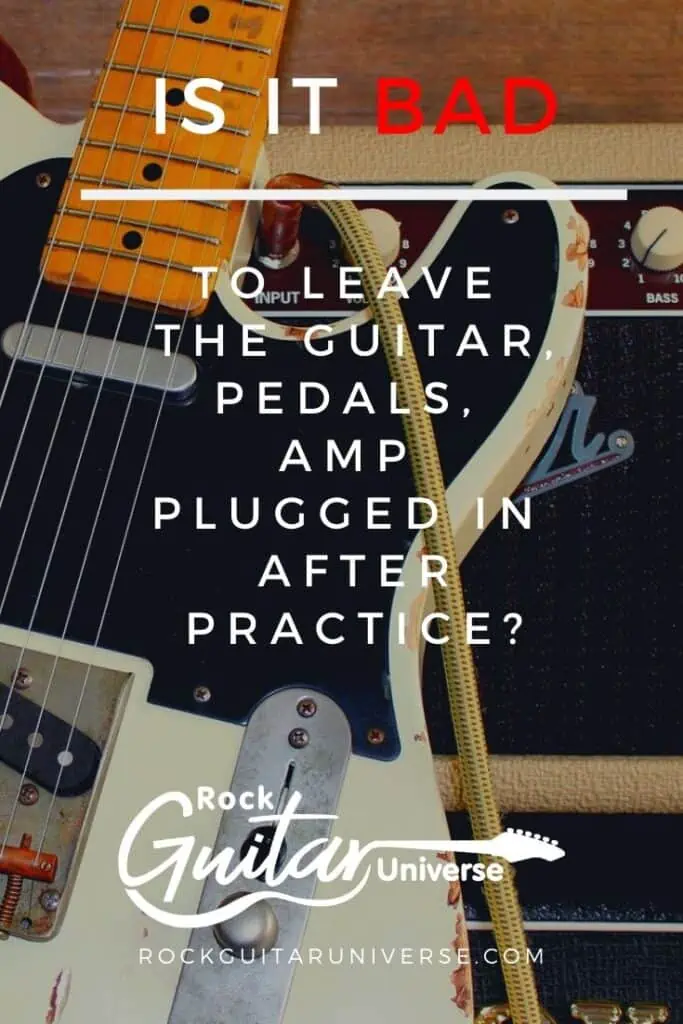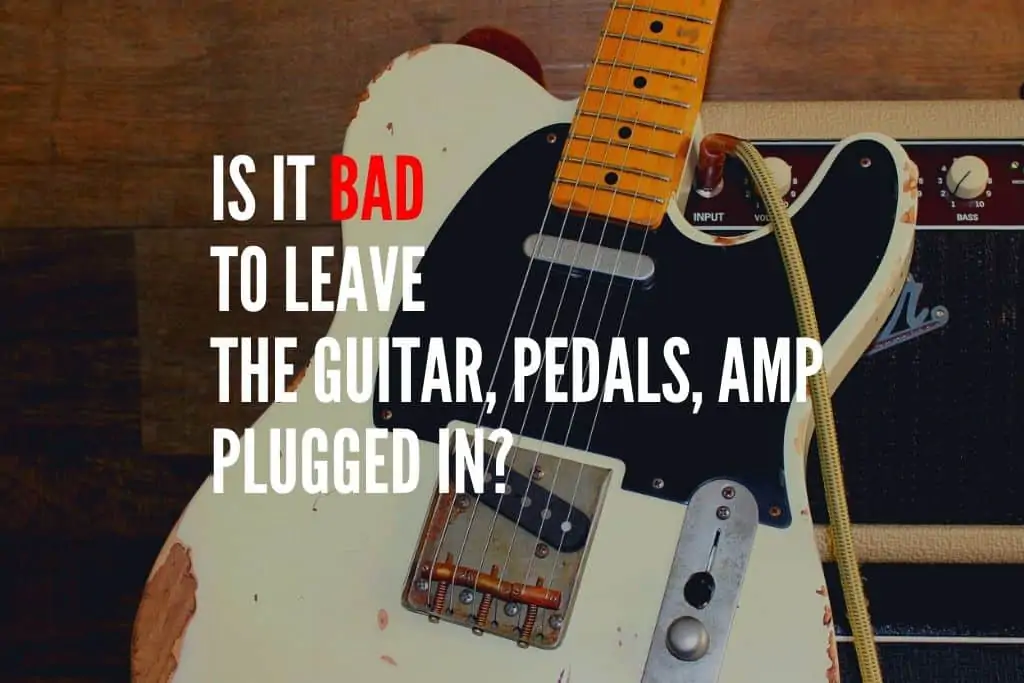If you ever played an electric guitar, you probably forgot to unplug it after you’ve finished playing or don’t want to unplug it because you will play it again tomorrow. Players usually don’t bother with those sorts of things, but it is a good idea to know what might happen if you leave the guitar, amp or pedals plugged.
So, is it bad to leave your equipment plugged in after practice? The answer is yes. While neither guitar nor your equipment can actually wear out, it is possible that you, or someone, will trip on the cable and damage the instrument or the equipment. Furthermore, power surges, humidity, and improper storage could also make an impact on your music equipment.
There are several reasons why leaving everything plugged in can cause harm to either the guitar or your equipment. Naturally, if you forget to unplug everything once, the chances of anything bad happening are rather slim, but it is not something that should grow into a habit.
if you are considering or already hanging your guitars on the wall, then you should check my post Is It Bad To Hang Guitars On The Wall By The Neck?
Cons Of Leaving The Equipment Plugged In
In general, you shouldn’t leave your equipment laying around, there is a chance that someone would damage it by accident. Even if you are extra careful around your equipment, other people might not have the same focus as you do. For example, someone could trip over the cable and break something, or they could spill their drink on any piece of equipment. All of this is easily avoided by simply storing your instrument and keeping everything in its place.
Leaving The Guitar Plugged In
If you own a guitar that has passive pickups, there is nothing that can happen if you leave it on. The basic principle of how electric guitar work describes that there is nothing that can go wrong if you leave the cable plugged. Naturally, this covers only electric discharges or any irregularities that could affect the guitar.
If we take a look at the science behind electric guitars, we can see that the sound that comes out of an amplifier is generated thanks to pickups. These pickups are basically several thousand windings of copper wire, wrapped around a permanent magnet. When we pluck the string, it will create a disturbance in the magnetic field which will generate a small current in the copper wire. The amp will amplify the signal, and we will be able to hear it through the speaker.
Now, if we leave the cable on, nothing will happen, regardless of the connector and output type. Of course, all of this can apply to the guitar with passive pickups. But what happens if you own a guitar with active ones?
Well, things might change a bit. Even though the basic principle is the same, there is one major difference. Active pickups have a circuit board inside the pickups, and the current that is generated in the winding is not enough to power it. As a result, the active pickup will require an additional voltage source. This source is usually a 9V battery. If you leave the cable plugged, the circuit will be closed, and as a result, the battery will run out of power sooner.
While it might seem unimportant, by unplugging your guitar, you will increase the number of hours you can use the battery. If your battery runs out, your guitar will become unplayable.
Of course, it is worth mentioning that by leaving the guitar cable plugged in, you can accidentally step on it and damage it. Furthermore, you will increase the chances of tripping on the cable and either end up hurting yourself or causing the guitar to fall. Naturally, if you keep all of the cables out of reach and safe from tripping, the only thing that might happen is for the battery to run out of power.
While solid-body guitars are great and don’t break easily, you can still cause damage to the finish if you trip on the cable. Furthermore, there are many guitars with headstocks that are rather fragile. If it happens that the guitar falls on the neck or headstock, it can crack or even break. Besides, hollow-body guitars are even more fragile, especially around the places where there are holes. For example, the part of the guitar where the jack is can be easily ripped if you pull the cord to hard. Besides, if you neglect the guitar or not do proper maintenance, there is a chance that the guitar, it’s quality, and performance would deteriorate.
Leaving The Pedals and Amp Plugged in
You might ask now if the same story can be applied to the pedals, and the answer is both yes and no. If you have several pedals, and if you leave them plugged in, you will need to consider buying additional batteries. Of course, this only applies if you use batteries for powering the pedals. If you use an adapter that is plugged into a socket, then there is nothing to worry about.
However, there is one thing that you should understand if you plan on leaving your adapter plugged in, and that’s power spikes. There is a chance that it will damage the electronics in the pedal or the adapter due to voltage spikes. Furthermore, by unplugging the pedal, you won’t have to worry about unexpected voltage spikes in the network. The same story applies to the amplifier and power spikes are the main threat to your electronic equipment.
We should also mention that leaving the pedals plugged both with batteries and adapter, as well as your amplifier, can cause electronics to wear out faster and degrade. While this is not something that will happen quickly, and there is a high chance that you won’t even notice it, it is still something that you should consider.
Most pedals use the stereo jack for input, which means that when the cable is unplugged, the circuit is opened. This means that nothing is in-circuit including batteries. On the other hand, when you plug the guitar, the chord will close the circuit and the batteries will drain slowly.
If you are not willing to unplug the amplifier after practice, there is one thing that you should seriously consider, and that is a surge protector. The main danger of electronic equipment is power surges. While it is not something that happens regularly, you should always consider the worst-case scenario and protect your gear. If you have a surge protector, you can freely leave the amplifier and pedals plugged in.
Naturally, there is a danger of tripping, but if you move all the cables from way, there is nothing that could actually happen. Furthermore, there are amplifiers that have a stand-by option that allows you to leave them turned on all the time if that’s something that you’d love.
Amplifiers are usually made to last for quite a long time, so the chances of anything happening to them are close to none. Naturally, the best way to do everything is to unplug it after you’re done playing. But with a good quality surge protector, there is almost nothing that can happen if you leave everything on.
One more thing that you should consider is tube amps. If you leave an amplifier with tubes turned on for too long, you can fry the tubes or lamps. While it is undoubtedly much easier to just turn the volume down, the last thing you need is to have to change all the tubes because you fried all of them. While this can be solved with simple re-tubing, it is much easier to avoid these replacements in the first place.
Storing Equipment
If your guitar or pedals require batteries, you should never toss them in a gig bag and think that everything will be well. If the battery makes contact either at the head or terminals, it can cause a fire. You should use a band or even tape to keep the battery terminals apart. This way, you will make sure that everything is properly stored and working. Even if it doesn’t end in fire, your batteries can run out of juice which will require you to unnecessarily spend money on getting new ones.
Proper storing applies not only to batteries but to the rest of your equipment as well. If you leave everything plugged in and laying around, your gear will be exposed to humidity which can cause harm to both the guitar and the equipment. It is much safer and easier to properly store everything after you’re done with your practice.
Furthermore, leaving everything plugged in can cause the batteries to leak, which can cause damage to the connectors or battery socket. If this happens, the best-case scenario is that you’ll have to replace the socket or just the battery. On the other hand, you might find yourself in a situation where you need to replace the entire preamp. Of course, you can always replace these, but to avoid any unnecessary repairs, it is much easier to simply unplug everything after your session.
Summary
It would be wrong to say that it is perfectly safe for every occasion to leave your guitar equipment plugged in. It is a recipe for equipment neglect. Whatever it is tripping over cables, draining batteries, power spikes, or poor maintenance and storage. In nine out of ten cases, nothing bad will happen, but the last thing you want to worry about is that tenth case. If you still desire to leave everything plugged in, then you should consider buying a surge protector, and moving cables and everything out of the way. If you cover all the steps, then there is no way that anything bad could happen to your gear. It is important to remember that you should take care of your equipment and prevent any damages to it. Finally, you should consider if avoiding a few seconds of extra work are worth potential pickups, preamp, or any other replacement.
If you found this article useful, you may want to save this pin below to your Guitar board.

2 thoughts on “Is It Bad To Leave The Guitar, Pedals, Amp Plugged In After Practice?”
Leave a Reply
Recent Posts
Some guitarists insist on buying an expensive amplifier with their electric guitar. They assume that this is a must for every type of guitarist out there. However, in some situations, this isn’t...
Top 50 Free Realistic Guitar VST Plugins With Sound Examples
As technology has rapidly advanced in the recent decade, computers are stealing more and more roles from physical musical instruments and accessories. Nowadays, you do not need expensive amps,...


Just read your post here. Could you please help me with something? What type of guitar tuner do you use? I’m thinking the kind that you plug into the pickup are probably the most accurate right? This would be for my acoustic/electric guitar. I appreciate the help.
Hi Veola,
I recommend using the KLIQ MetroPitch